Diving equipment
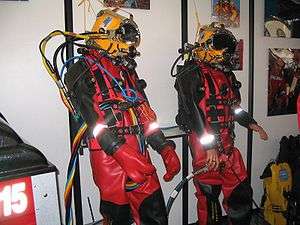 Surface supplied commercial diving equipment on display at a trade show | |
| Other names | Dive gear |
|---|---|
| Uses | Facilitate underwater diving operations |
Diving equipment is equipment used by underwater divers to make diving activities possible, easier, safer and/or more comfortable. This may be equipment primarily intended for this purpose, or equipment intended for other purposes which is found to be suitable for diving use.
The fundamental item of diving equipment used by divers is underwater breathing apparatus, such as scuba equipment, and surface supplied diving equipment, but there are other important pieces of equipment that make diving safer, more convenient or more efficient. Diving equipment used by recreational scuba divers is mostly personal equipment carried by the diver, but professional divers, particularly when operating in the surface supplied or saturation mode, use a large amount of support equipment not carried by the diver.
Equipment which is used for underwater work or other activities which is not directly related to the activity of diving, or which has not been designed or modified specifically for underwater use by divers is excluded.
Classes of underwater breathing apparatus
- Surface supplied diving[1] - mostly used in professional diving. This category includes:
- Surface oriented surface supplied diving (Bounce diving), where the diver starts and finishes the dive at normal atmospheric pressure.
- Saturation diving, where the diver remains under pressure in an underwater habitat or saturation spread between underwater excursions.
- Standard diving dress - mostly used in professional diving. Mainly of historical interest now.
- Airline or Hookah diving.
- "Compressor diving" - a rudimentary form of surface supplied diving used in the Philippines by artisanal fishermen.
- Recreational forms like snuba.
- Scuba diving - The use of self-contained underwater breathing apparatus. This category includes:
- Open-circuit scuba consisting of diving cylinder(s) and diving regulator(s)
- Rebreather, closed-circuit or semi-closed-circuit scuba
- Free diving or breathhold diving, where the diver completes the dive on a single breath of air taken at the surface before the dive.
- Snorkel allows breathing at the surface with the face submerged, and is used as an adjunct to free diving and scuba.
- Atmospheric diving suits and other submersibles which isolate the diver from the ambient environment. These are not considered here.
- Liquid breathing systems are extremely rare and at an early experimental stage. It is hoped that some day practical systems will allow very deep diving. This is not considered here.
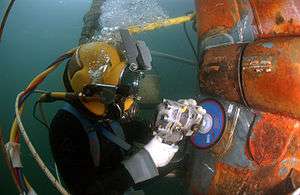 A US Navy diver at work. The umbilical supplying air from the surface is clearly visible
A US Navy diver at work. The umbilical supplying air from the surface is clearly visible Diver in standard diving dress entering the water at Stoney Cove, England
Diver in standard diving dress entering the water at Stoney Cove, England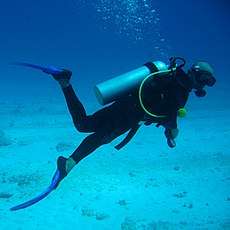 Scuba diver with single cylinder and open circuit regulator
Scuba diver with single cylinder and open circuit regulator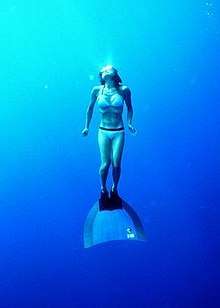 Free-diver with monofin, ascending
Free-diver with monofin, ascending The Newtsuit is an atmospheric diving suit which has fully articulated rotary joints in the arms and legs.
The Newtsuit is an atmospheric diving suit which has fully articulated rotary joints in the arms and legs.
Personal diving equipment
This is the diving equipment worn by or carried by the diver for personal protection or comfort, or to facilitate the diving aspect of the activity, and may include a selection from:
Underwater breathing apparatus
- Scuba equipment: Primary cylinder(s), carried back-mounted or side mounted and open circuit regulator(s), or rebreather sets. Alternative air source such as bailout bottle or pony bottle, and decompression cylinders and their associated regulators. Secondary demand valve (Octopus).
- Surface supplied equipment: Helmet or full face mask, diver's umbilical, airline, bailout block, bailout cylinder and regulator.
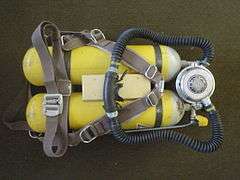 Early twin cylinder set with twin hose regulator
Early twin cylinder set with twin hose regulator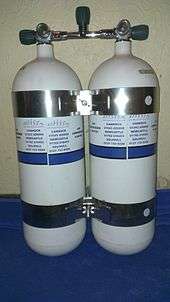 Twin scuba cylinders with isolation manifold
Twin scuba cylinders with isolation manifold Charging a small bailout cylinder from a larger aluminium scuba cylinder
Charging a small bailout cylinder from a larger aluminium scuba cylinder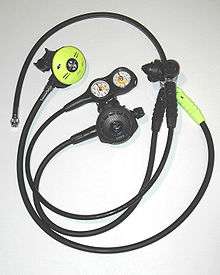 Scuba regulator: First stage with primary and secondary demand valves, submersible pressure gauge and low pressure hose for BC inflation.
Scuba regulator: First stage with primary and secondary demand valves, submersible pressure gauge and low pressure hose for BC inflation.- Technical diver with back mounted open circuit scuba and sling mounted decompression cylinders
- Diving with a closed circuit rebreather
- Russian made IDA-71 rebreather set
- Heavy standard diving helmet, lightweight demand helmet and band mask
%2C_is_fitted_with_a_Kirby_Morgan_37_Dive_Helmet.jpg) Diver wearing lightweight demand helmet
Diver wearing lightweight demand helmet
Exposure protection
Thermal, sting and abrasion protection.
- In cold water, a diving suit such as a dry suit (at temperatures of 0-10 °C), a wet suit (at temperatures of 21-25 °C), or a Hot water suit (surface supplied diving only) is necessary.
- Boiler suit overalls are often worn over the thermal protection suit by commercial divers as abrasion protection
- In very warm water (temperatures of 26-30 °C), many types of tough, long, everyday clothing provide protection, as well as purpose made garments such as dive skins (made of lycra) and shorty wetsuits. In some cases, simple regular swimsuits are also used.[2]
- Diving gloves, including wetsuit gloves and dry gloves, mitts, and three-finger mitts
- Diving hoods
- Diving boots - With dry suits, the boots are usually integrated.
- Safety helmet for scuba diving. (Not part of the breathing apparatus.)
- Diving chain mail may be used as protection against bites by large marine animals
- Diver's cages may be used as protection against large predators
 Full wet suit
Full wet suit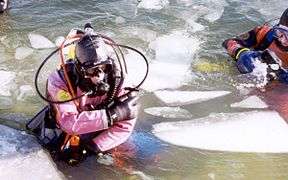 Dry suits
Dry suits Short and full length wet suits
Short and full length wet suits- Wet suit boots
- Neoprene diving gloves
In-water stabilisation and movement
- A backplate is a structure onto which the back-mounted diving cylinders are mounted, usually linking the buoyancy compensator with the weight of the diving cylinders and provided with a harness of straps which secures the scuba set to the diver's back. A backplate is generally used with a back inflation (wing) type buoyancy compensator, but can also be used without any buoyancy compensator.
- Buoyancy compensator, also known as Buoyancy Control Device, BCD or BC - is usually a back mounted or sleeveless jacket style device which includes an inflatable bladder used to adjust the buoyancy of the diver under water, and provide positive buoyancy at the surface. The buoyancy compensator is usually an integral part of the harness system used to secure the scuba set to the diver. The earlier collar style buoyancy compensator is seldom used any more.
- Diver Propulsion Vehicle - to increase the range of the diver underwater
- Diving weighting system - to counteract the buoyancy of the diving suit and diver to allow descent. Professional divers may use additional weighting to ensure stability when working on the bottom
- Fins for efficient propulsion
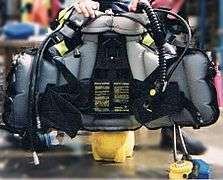 Jacket buoyancy compensator
Jacket buoyancy compensator Diver propulsion vehicle (scooter)
Diver propulsion vehicle (scooter)- Weight belt
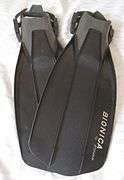 Swim fins
Swim fins
Equipment for dive monitoring and navigation
- Depth gauge lets the diver monitor depth, particularly maximum depth and, when used with a watch and Decompression tables, also allows the diver to monitor decompression requirements. Some digital depth gauges also indicate ascent rate which is an important factor in avoiding decompression sickness
- Pneumofathometer is the surface supplied diving depth gauge which displays the depth of the diver at the surface control panel.
- Dive computer helps the diver to avoid decompression sickness by indicating the decompression stops needed for the dive profile. Most dive computers also indicate depth, time and ascent rate. Some also indicate oxygen toxicity exposure and water temperature, and may provide other functions.
- Dive timer is an instrument that displays and records depth and elapsed time during the dive. It is usually possible to extract the information after the dive. This function is often available as "Gauge setting" on dive computers.
- Diving watch is used with depth gauge for decompression monitoring when using decompression tables. Largely superseded by dive computers, where elapsed time is one of the standard displays, and time of day may also be available.
- Diving compass for underwater navigation. This is often a selectable function of a dive computer.
- Submersible pressure gauge, also known as a "contents gauge" is used to monitor the remaining breathing gas supply in scuba cylinders.
- Distance line or "come-home-line" can used to guide the diver back to the start point and safety in poor visibility.
- A cave line is a line laid by a diver while penetrating a cave to ensure that the way out is known. Permanent cave lines are marked with line markers at all junctions, indicating the direction along the line toward the nearest exit.
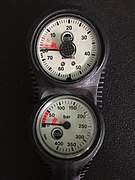 A depth gauge and submersible pressure gauge
A depth gauge and submersible pressure gauge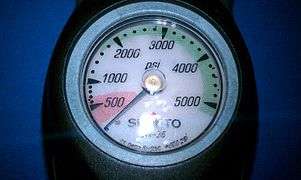 Suunto submersible pressure gauge
Suunto submersible pressure gauge A surface supply panel for four divers showing four pneumofathometer gauges
A surface supply panel for four divers showing four pneumofathometer gauges
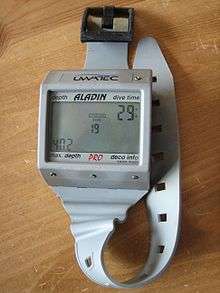 Uwatec Aladin Pro dive computer showing the log of a previous dive
Uwatec Aladin Pro dive computer showing the log of a previous dive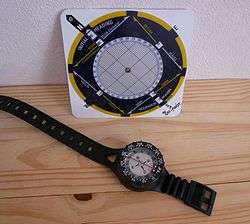 Nav finder and underwater compass - basic underwater navigation tools.
Nav finder and underwater compass - basic underwater navigation tools.- Suunto SK-7 diving compass in aftermarket wrist mount with bungee straps
 Shearwater Perdix and Ratio iX3M GPS dive computers in compass mode
Shearwater Perdix and Ratio iX3M GPS dive computers in compass mode- 50 metres of line on a reel
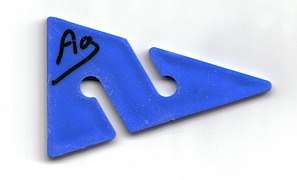 Line Arrow Marker
Line Arrow Marker- A miniature submersible pressure gauge (mini SPG) used on pony cylinders
Vision and communication
- Masks allow the diver to see clearly underwater and protect the eyes.
- Full face masks protect the face from dirty or cold water and increases safety by securing the gas supply to the diver's face. If it contains no mouthpiece, the diver can talk allowing the use of communications equipment.
- Half masks cover only the eyes and nose. The diver breathes from a separate mouthpiece on the regulator or rebreather.
- Diving helmets are often used with surface supplied diving. They provide the same benefits as the full face mask but provide a very secure connection of the gas supply to the diver and additionally protect the head.
- Underwater writing slates and pencils are used to transport pre-dive plans underwater, to record facts whilst underwater and to aid communication with other divers.
- Dive lights, which are usually waterproof and pressure rated torches or flashlights, are essential for safety in low visibility or dark environments such as night diving and wreck and cave penetration. They are useful for communication and signalling both underwater and on the surface at night. Divers need artificial light even in shallow and clear water to reveal the red end of the spectrum of light which is absorbed as it travels through water. Underwater video lights can serve the same purpose.
- Hand-held sonar for a diver can provide a synthetic view using ultrasonic signals emitted and processed by an electronic device and displayed on a screen.
- Ultrasonic signalling devices which attract the buddies attention by vibration have been marketed and may have some limited utility.[3]
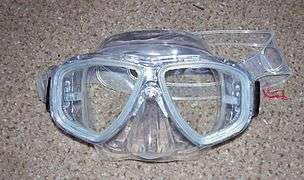 A diving half mask provides clear sight and protection for the eyes.
A diving half mask provides clear sight and protection for the eyes.- A full face mask covers the eyes, nose and mouth.
- One piece LED dive light with soft Goodman type handle
 A "canister" style dive light
A "canister" style dive light
Safety equipment
- Diver's safety harness, to which a lifeline may be attached, including Bell harness, AR vest, Jump jacket.
- Lifeline (or tether): A line from the diver to a tender at the surface control point, which may be used for:
- communications, by diving line signals,
- to allow the diver to be found by the stand-by diver following the line,
- to provide a guideline to the surface control point to guide the diver on return,
- to assist the diver to maintain position in a current,
- in an emergency, to recover the diver to the surface, and
- in some cases lift the diver out of the water.
- Shotline: A line connecting a shot weight to a marker buoy, used to mark a dive site and provide a vertical reference for descent and ascent.
- Buddy line: A short line or strap connecting two divers in the water, used to prevent them from being separated in poor visibility and for communication by line signals.
- Jonline: A short line or webbing strap to tether the diver to the shotline in a current.
- Surface marker buoy, which indicates the position of the divers to people at the surface.
- DSMB - (Delayed, or deployable surface marker buoy), or decompression buoy which is inflated at the start of, or during the ascent, to indicate the position of the divers to the surface team, and as a signal that the divers are ascending.
- Cutting tool
- Knife to cut lines, nets or to pry or dig. Can also be used for personal protection against underwater predators if needed. However, this latter use is not recommended, as it is generally ineffective.
- Diver's net or line cutter. This is a small handheld tool carried by scuba divers to extricate themselves if trapped in fishing net or fishing line. It has a small sharp blade such as a replaceable scalpel blade inside the small notch. There is a small hole at the other end to for a lanyard to tether the cutter to the diver.
- Trauma shears. Very effective as a line cutter, with low risk of inadvertent injury or damage. Usually carried in a pocket or special purpose sheath.
- Automatic diver recovery devices
 Front view of jacket style diver harness with removable weight pockets
Front view of jacket style diver harness with removable weight pockets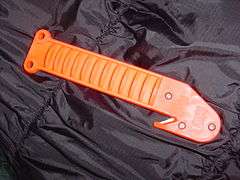 scuba diver's net cutter. 7 inches long
scuba diver's net cutter. 7 inches long- Underwater Kinetics general purpose dive knife
- Trilobite line cutter with sheath on diving harness
 Trauma shears
Trauma shears DiverGuard automatically inflates the buoyancy compensator if the diver stops breathing.
DiverGuard automatically inflates the buoyancy compensator if the diver stops breathing.- Spool with line and double-ender clip
- Dive reel with stored DSMB
 A stainless steel line holder with a 20-metre line
A stainless steel line holder with a 20-metre line
Surface detection aids
The purposes of this class of personal equipment are to:
- allow the support boat to monitor and find divers on the surface during or after a dive
- prevent the diver being struck by boat traffic
- mark the diver's position when drift diving or while at the decompression stop
- help rescue services in lifeboats and helicopters to locate the diver
Surface detection aids include:
- Surface marker buoy, decompression buoy, delayed SMB, safety sausage or blob
- Red or yellow collapsible flag - high visibility, robust, usually stored bungeed to cylinder
- Whistle - cheap, will only be heard by people far from engine noise
- Torch or flashlight - if at sea after nightfall
- Strobe light - needs long-lasting batteries
- High pressure whistle - expensive but effective
- Orange dye marker - increases diver's visibility from search helicopters
- Mirror such as a used compact disc - to reflect sunlight or searchlights
- Red pyrotechnic flares - for helicopters and lifeboats
- ENOS Rescue-System
- Emergency position-indicating rescue beacon (EPIRB)
- Glow stick - for night diving
Personal tools and accessories

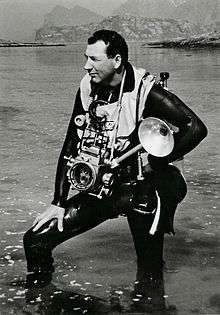
- Camera, strobe (flash), video lights and housing - for underwater photography or underwater videography
- Diving reel, spool or line holder to store and transport a distance line or line for a surface marker buoy. A spool is a small flanged cylinder with an axial hole, around which a length of line can be wound, and a line holder is a flat H-shaped piece of rigid sheet material on which a length of line can be wound, as an alternative to a reel or spool. The line may be used with a surface marker buoy or a delayed surface marker buoy, where negative buoyancy of the spool or line holder will help with unwinding the line underwater.
- Dry box to hold objects the diver needs to keep dry at depth (wallet, cell phone)
- Dry bag to carry items that must stay dry on the boat.
- Dive bag to hold equipment for travel.
- Tool bag to carry tools that may be required for the job. Various types and sizes are available.
- A rescue tether is a short lanyard or strap carried by a surface supplied stand-by diver to be used to tether an unresponsive diver to the standby diver during a rescue. It is attached at one end to a D-ring on the stand-by diver's harness, and has a clip at the other end which may be secured to a D-ring on the casualty's harness to allow the rescuer the use of both hands during the return to the bell or surface.

Diving team tools and equipment
- A jackstay is a line laid along the bottom to guide the diver during a search or to and from the workplace.
- Lifting bags, an item of diving equipment consisting of a robust and air-tight bag with straps, which is used to lift heavy objects underwater by means of the bag's buoyancy when filled with air.
- A shot line, consisting of a weight, line and buoy is used to used to mark the location and identify the ascent and descent point of a dive site, allowing divers to navigate to and from the surface and to do decompression stops at a safe location and to help control rate of ascent and descent.
- Decompression trapeze is used to assist in maintaining correct depth during in-water decompression stops
- Diving bells and diving stages are used to transport divers from the surface to the underwater workplace.
Surface support equipment connected with diving and underwater work


- Diver down flag is flown warning others that divers are underwater
- Diving air compressor to fill diving cylinders with high pressure air or other gasses
- Surface supplied diving breathing gas supply system, including:
- Boats such as the rigid-hulled inflatable boat
- Dive platforms (or swim platforms) on boats.
- Boarding ladders, particularly the Christmas tree ladder configuration, with a single central rail and cantilevered rungs on both sides, which allows a diver to climb while wearing fins.
- Echo sounder - a Sonar depth measuring and profiling device used for dive site location
- GPS receiver - for locating dive sites
- Proton magnetometer - for locating ferrous wrecks
- Marine VHF radio - for communicating with rescue services and other boats
- Saturation systems providing surface support for saturation diving.
- Diving chambers for surface decompression and treatment of decompression illness
- Diving support vessels
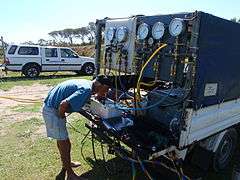 Surface supply air panels. On the left for two divers, on the right for three divers
Surface supply air panels. On the left for two divers, on the right for three divers A hard-wired diver communications unit mounted in a waterproof box for convenience of transport and protection.
A hard-wired diver communications unit mounted in a waterproof box for convenience of transport and protection. Personnel Transfer Capsule - a dry bell
Personnel Transfer Capsule - a dry bell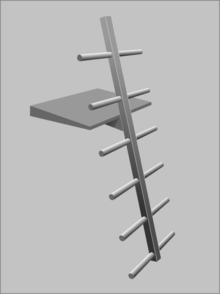 Christmas tree style diver's boarding ladder
Christmas tree style diver's boarding ladder
Special equipment for underwater work not carried by the diver
- Remotely operated underwater vehicle - for locating dive sites
References
- ↑ Beyerstein, G (2006). "Commercial Diving: Surface-Mixed Gas, Sur-D-O2, Bell Bounce, Saturation". In: Lang, MA and Smith, NE (eds). Proceedings of Advanced Scientific Diving Workshop. Smithsonian Institution, Washington, DC. Retrieved 2013-03-19.
- ↑ Halls, Monty (2007). Go scuba dive. Dorling Kindersley. ISBN 978-1405318211.
- ↑ Gronfeldt, Thomas (11 November 2016). "Gear Review: The Buddy-Watcher". scubadiverlife.com. Retrieved 25 October 2017.
External links
![]()